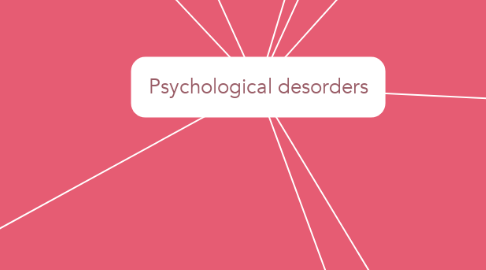
1. Personality disorders
1.1. Cluster A
1.1.1. People with these disorders display a personality style that is odd or eccentric.
1.1.1.1. Paranoid
1.1.1.2. Schizoid
1.1.1.3. Schizotypal
1.2. Cluster B
1.2.1. People with these disorders usually are impulsive, overly dramatic, highly emotional, and erratic
1.2.1.1. Antisocial
1.2.1.2. Histrionic
1.2.1.3. Narcissistic
1.2.1.4. Borderline
1.3. Cluster C
1.3.1. People with these disorders often appear to be nervous and fearful
1.3.1.1. Avoidant
1.3.1.2. Dependent
1.3.1.3. Obsessive compulsive
2. Dissociative disorders
2.1. Dissociative amnesia
2.1.1. The individual is unable to recall important personal information. It usually follows an extremely stressful or traumatic experience.
2.2. Depersonalization
2.2.1. The person believes his/her movements, thoughts and feelings are not their own
2.3. Derealization
2.3.1. The person feels that the world surrounding them is not real
2.4. DID
2.4.1. People with dissociative identity disorder exhibit two or more separate personalities or identities, each well-defined and distinct from one another. Causes: 95% were
3. Psychotic disorders
3.1. Schizophrenia
3.1.1. Is considered a psychotic disorder - the person's thoughts, perceptions, and behaviors are impaired to the point where he/she is not able to function normally in life
3.1.1.1. Symptoms
3.1.1.1.1. Hallucination: A perceptual experience that occurs in the absence of external simulations
3.1.1.1.2. Delusions: Beliefs that are contrary to reality and are firmly held even in the face of contradictory evidence (paranoid, grandiose or somatic)
3.1.1.1.3. Disorganized thinking: incoherent thought processes
3.1.1.1.4. Disorganized or abnormal motor behavior: Unusual behaviors and movements (very active or catatonic).
3.1.1.1.5. Negative symptoms: Noticeable decreases and absences in certain behaviors, emotions, or drives.
4. The person often experiences mood states that vacillate between depression and mania.
4.1. Manic Episode: Distinct period of abnormally and persistently elevated, or irritable mood and abnormally activity or energy.
5. Anxiety Disorders
5.1. Phobia
5.1.1. "Intense, unreasonable and persistent fear caused by the presence or anticipation of a specific object or situation."
5.2. Social Anxiety Disorder
5.2.1. Is characterized by extreme end persistent fear or anxiety and avoidance of social situations in which the person could potentially be evaluated negatively by others.
5.3. Panic Disorder
5.3.1. Episodes of about 10 minutes where inexplicably there is sweating, trembling, heart pounding, and trouble breathing, including dizziness and nausea.
5.4. Generalized anxiety disorder
5.4.1. Is a relatively continous state of excessive, uncontrollable, and pointless worry and apprehension. People with generalized anxiety disorder often worry about routine, everyday things, even though their concerns are injustified.
6. Obsessive compulsive and related disorders
6.1. OCD
6.1.1. People with this disorder experience thoughts and urges that are intrusive and unwanted (obsessions) and/or the need to engage in repetitive behaviors or mental acts (compulsions).
6.2. Body dysmorphic
6.2.1. The person is preoccupied with a perceived flaw in their physical appearance that is either nonexistent or barely noticeable to other people. Engages in repetitive and ritualistic behavioral and mental acts, such as constantly looking in the mirror, trying to hide the offending body part, and comparisons with others.
6.3. Hoarding
6.3.1. People with hoarding disorder cannot get rid of personal possessions, regardless of how valueless or useless the possessions are.
7. Mood disorders
7.1. Trauma and stressor disorders
7.1.1. PTSD
7.1.1.1. Extremely stressful or traumatic events, such as combat, natural disasters, and terrorist attacks, place the people who experience them at an increased risk for developing psychological disorders such as post-traumatic stress disorder.
7.2. Major Depressive disorder
7.2.1. Seasonal
7.2.2. Persistent
7.2.2.1. Depressed moods most of the day nearly every day for at least two years, as well as at least two of the other symptoms
7.2.3. Postpartum

